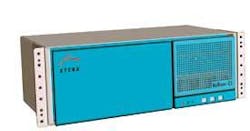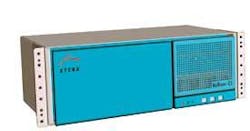Xtera extends scalability with Nu-Wave ES
by Meghan Fuller
The last time Xtera Communications (www.xtera.com) was profiled in this space, back in 2002, the company had just announced that it would no longer manufacture S- and L-band amplifier subsystems. Instead, the company launched its own DWDM system, dubbed “Nu-Wave,” to satisfy carriers’ seemingly insatiable demand for reach and capacity. Unfortunately, “the timing just wasn’t good,” in the recent words of marketing vice president Daryl Chaires, and the telecom market bust that followed forced the company to reinvent itself again.
Five years, a new CEO, and a brighter market later, Xtera has not only weathered the storm, but it’s inking new customers and announcing new products, including the Nu-Wave ES DWDM Transport System, which the company claims redefines the pay-as-you-grow paradigm to include the optical line system.
When current chief executive John Hopper was appointed in 2004, he came with a background not in optics but electronics. However, he had extensive experience taking pre-IPO companies and helping them go public, says Chaires, who notes that Hopper immediately “cut the company down to the bare minimum” and refocused Xtera on what it needed to do to survive. Rather than continue to push its ultralong-haul platform-a tough sell during the bust-Xtera turned instead to the optical add/drop multiplexer (OADM) segment, which was the only segment experiencing growth at that time.
“What sets Xtera apart is it doesn’t use EDFAs in its systems at all,” reports Chaires. “It uses all-Raman amplification, both on its terrestrial systems as well as the unrepeatered systems. So the first thing Xtera did was introduce OADMs using an all-Raman technology,” he recalls.
While typical EDFA-based systems might be limited to seven or eight OADM sites, Raman technology enables the Nu-Wave system to “cascade forever,” in Chaires’ words. Raman amplification provides better noise performance than EDFA, he says, enabling longer amplifier spans and all-optical transmission links.
Today, Xtera is leveraging that OADM expertise in the Nu-Wave portfolio, which now extends from the ultralong haul to the metro, including the recently released Nu-Wave ES or Extended Scalability. Designed for carriers with lower bandwidth requirements in emerging markets like Africa and South America, the new platform also is well suited for any carrier looking to minimize its initial capital investment while preparing for increased bandwidth requirements in the future, says Chaires.
Because the uptake of next-generation services can be unpredictable, carriers typically must spend more capital and deploy far more capacity than they will need at the outset. The Nu-Wave ES helps mitigate this risk by lowering initial deployment costs without sacrificing overall network capacity.
According to Chaires, the Nu-Wave ES is unique because it provides scalability of both the terminal and line systems. All WDM suppliers say they have a pay-as-you-grow strategy, but that strategy is limited to the terminal end of the WDM system, he contends. Other WDM system vendors allow their customers to pay for only those transponders they need, as they need them. Xtera’s Nu-Wave ES, by contrast, extends that pay-as-you-grow strategy to both the terminal and the line system.
While typical EDFA-based WDM systems require a second amplifier to support more than 80 wavelengths, Xtera says its Raman technology has enabled it to develop a system that is expandable from 30 to 150 wavelengths without adding additional amplifiers. Instead, the company’s proprietary technology allows it to expand the supported spectrum of its existing amplifier.
“That means the amplifier can actually start out supporting 30 channels as opposed to 80 channels or 240 channels,” explains Chaires. In fact, Xtera says its Nu-Wave ES provides a 63% reduction in initial optical line system capacity.
Thanks to its use of Raman technology, Xtera says the Nu-Wave ES can support a mix of 10- and 40-Gbit/sec traffic, making the system applicable to all markets. And it can be deployed in a multidegree node configuration, supporting two to eight degrees of per-channel reconfigurability.
